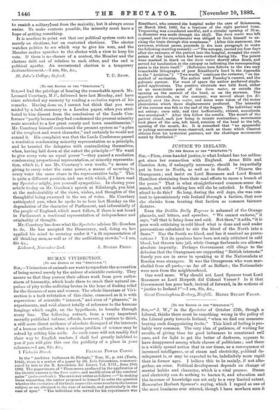HUMAN VIVISECTION.
[TO THE EDITOR OF THE "SPECTATOR."]
Sra,—Vivisectors of animals are wont to repudiate the accusation of being moved merely by the ardour of scientific curiosity. They assure us that they pursue their odious work from pure enthu- siasm of humanity, which leads them to crush their natural im- pulses of pity to the suffering brutes in the hope of finding relief for the diseases of men and women. The whole literature of Vivi- section is a tacit refutation of this claim, crammed as it is with expressions of scientific " interest," and even of " pleasure," in experiments, and void almost totally of reference to the humane longings which ought, on the hypothesis, to breathe through every line. The following extract, from a very important recently published volume, affords, however, I venture to think,
a still more direct evidence of absolute disregard of the interests of a human sufferer, when a curious problem of science may be solved by setting him aside. As such cases will not readily find their way to English readers, I shall feel greatly indebted to you if you will give this one the publicity of a place in your
columns.—I am, Sir, Ac.,
In the "Archives ltaliennes do Biologie," Tom. II., p. 441 (Turin, 1882), there is a review of a paper by Dr. Ezio Sciamauna, communi- cated by him to the R. Accademia del Liucei, Vol. XIII., June 25th 1882. The paper treats of " Phenomena produced by the application of the electric current to the dura mater, and modification of the cerebral pulse " (polso cerebrate). The reviewer writes as follows :—" In making these researches, the author proposed to himself to solve the question whether the excitation of the brain causes the same results in the human subject as are obtained in the case of animals, and particularly in the case of apes." "The individual who served for his experiments was Rinalducci, who entered the hospital under the care of Sciamanna, on March 23rd, 1882, for a fracture of the right parietal bone. Trepanning was considered needful, and a circular opening of 35 m. in diameter was made through the skull. The dura mater was left exposed, and the experimenter was obliged to limit himself to ex- citing the brain through this membrane." (After this statement, the- reviewer, without pause, proceeds in the next paragraph to make the following startling remark) :—" The autopsy, carried oat four days after the entrance of the patient into the hospital, revealed the exact points of the brain which had been excited during life. The points- were marked in black on the dura mater shortly after death, and served for localisation at the autopsy as indicating the corresponding parts in the brain itself." (Reference here follows to the two very remarkable lithographs of poor Rinaldacci's head in the Appendix_ to the "Archives.") "Two words," continues the reviewer, "on the method of excitation. The author used Faraday's current, and the- galvanic current. For want of space the author preferred single- poled applications. The positive electrode was held fixed, either- on an unexcitable point of the dura mater, or outside the opening on the summit of the head, or on the sternum. The negative electrode, on the contrary, was moved about (on di- placait) over the dura mater, and notes were taken of the motor phenomena which these displacements produced. The intensity of the current was felt to the end of the fingers. The individual was not asleep ; once only, and that ineffectually, chloral, anmsthesia was attempted." After this follow the results. The mouth of the patient closed, each jaw being in tetanio contraction; movements- took place of the arm, left hand, rotation of the head to the left, opening of the mouth, ecc. It is remarked that "no spasmodic or jerking movements were observed, such as those which Cheroot obtains from his hysterical patients, nor the choreique movements. noted by Barthalaw."


































 Previous page
Previous page